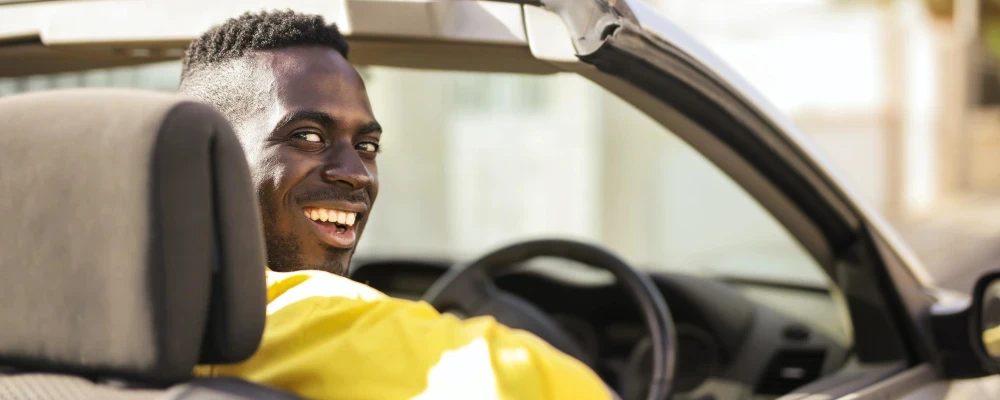Stacked Vs. Unstacked Insurance
Learn about stacked and unstacked insurance and find out which type is right for you with our guide.
Our content follows strict guidelines for editorial accuracy and integrity. Learn about our and how we make money.
If you’re new to auto insurance or recently decided to look for a new plan, learning about your different coverage options is important.
One insurance practice that is particularly important to understand is stacking your insurance vs. unstacked insurance. Depending on where you live, you may be able to combine policy coverage amounts, and this can help if you’re ever in an accident and need to cover medical treatment.
This article will cover stacked vs. unstacked insurance for auto coverage and tell you everything you need to know about both options, as well as the benefits of each.
What Is Auto Insurance?
By law, every vehicle in the U.S. is required to have auto insurance in order to legally drive on the road.
Having the right auto insurance can save you a lot of time, headaches, and hassle if you're ever involved in an auto accident or collision.
There are three main types of auto insurance coverage that you can get:
Liability insurance covers the damage that a person may cause but doesn’t insure the policyholder. For example, if a person with liability insurance crashes into another car, their car insurance will cover the repairs for the other person.
Collision insurance is insurance for on-road motor accidents and collisions. It will cover a policyholder in the event of them having an accident with another vehicle or object while driving. However, this car insurance won’t cover a policyholder for other types of damage such as rodent damage, theft, or fire damage.
Comprehensive insurance is generally more expensive but it offers policyholders the most amount of protection. If you have a comprehensive insurance plan, you’ll be covered for accidents, fire damage, theft, glass repairs, third-party claims, and medical costs.

Source: Pexels
How Do I Find My Coverage Limits?
With every car insurance plan, there are coverage limits for different types of costs that can be seen in your insurance contract.
These are usually reflected in three numbers after the type of policy (Bodily injury to one person/Bodily injury to multiple people/Property damage).
Bodily injury to one person: This is the amount of coverage your policy will provide to one person who is injured in the accident.
Bodily injury to multiple people: This is the total amount of cover that your insurance will pay for injuries to multiple people in an accident.
Property damage: This is the maximum coverage limit for damage to property.
For example, if your coverage offers (20/25/5) this means you’ll have:
$20,000 in bodily injury to one person.
$25,000 in bodily injury to multiple people.
$5,000 in property damage cover.
Each state has its minimum liability limits for each of these and this is what minimum liability insurance is.
For example, in California, the minimum liability amount is (15/30/5) while in Florida, the minimum liability insurance is $10,000 for property damage liability and $10,000 for personal injury protection (PIP).
There are also other types of insurance that you can get, such as
Uninsured motorist coverage.
Underinsured motorist coverage.
Both of these plans cover a policyholder in case they are involved in an accident with a driver who is uninsured or underinsured.
This can be extremely important if you’re involved in an accident and the other driver doesn’t have enough coverage to pay for:
Your medical expenses.
Lost wages.
Pain and suffering.
Funeral costs.
In some cases, car damage.
This is what stacked car insurance is all about. In most states, the state minimum liability is set quite low, and it may not be enough to cover you. People buy both uninsured motorist coverage and underinsured motorist coverage to make sure that they can pay for hospitalization and treatment for themselves and other people injured in an accident.
No-Fault vs. At-Fault States
Another layer of complexity is how insurance works in your state. If you live in an at-fault state, the person who caused the accident will be liable for the expenses related to treatment and repairs.
If you live in a no-fault state, each party involved in an accident will need to pay their own costs of repairs, damage, and medical care if they are involved in a collision.
However, in both cases, it’s crucial to have enough coverage to pay for any costs that come from a motor vehicle accident. This is why stacking your insurance can be beneficial.

Source: Pexels
What Is Stacked Car Insurance?
Stacked insurance is simply the act of combining multiple bodily injury insurance limits under one policyholder.
If a motorist is underinsured it means that they won’t be able to cover your costs of medical care if you are injured in a collision or accident. This means you’ll be left with a large medical bill and you’ll have to sue the person for damages, which will cost a lot of money and take time.
Stacked insurance allows people to increase their coverage to make sure they are financially protected if they’re ever injured or hurt in a motor collision.
Let’s use an example to understand why stacked insurance can be helpful.
Let’s say you’re involved in an accident caused by another driver and you need urgent medical care that ends up costing $75,000. However, the person who caused the accident only has minimum liability insurance with coverage of $25,000 for bodily injury to an individual.
Your insurance policy covers $30,000 in bodily injury costs, so there will still be a shortfall of $20,000 that will need to be paid by you once you’re released from the hospital.
With stacked insurance, you can lessen this amount by combining different policy coverage amounts.
What Does Underinsured Mean?
Underinsured is a situation where a person doesn't have enough insurance coverage to cover the costs of repairs, theft, or replacement.
For example, if you have a car worth $15,000 and only have insurance for a vehicle valued at $10,000, you’d be classified as underinsured.
The opposite of underinsured is overinsured, which is when you have too much insurance. A consequence of this is that you’ll be paying high premiums each month for coverage you don’t need.

Source: Unsplash
How Stacked Insurance Works
With stacked insurance, people combine the personal injury liability coverage limits across multiple insurance policies. Let’s use an example to learn how stacked insurance works and how it compares to unstacked insurance.
Meet Bill
Bill has three vehicles with three insurance policies under his name and lives in a state where stacking is allowed.
- Vehicle 1 has uninsured or underinsured driver coverage of $22,000.
- Vehicle 2 has uninsured or underinsured driver coverage of $25,000.
- Vehicle 3 has uninsured or underinsured driver coverage of $17,000.
Bill is driving Vehicle 3 one day on a busy road when another driver cuts in front of him and causes an accident.
He is injured in the accident and needs to be hospitalized. Bill goes to the hospital and receives treatment and is released two weeks later.
One day, he gets a letter in the post from the hospital with a bill of $75,000 for the services they rendered.
He calls his car insurance company and asks them what coverage the other driver had for his injuries.
The insurance consultant says that the other driver had $20,000 in coverage for personal injury liability.
Let’s take a look at how this affects Bill’s medical expenses:
Total Medical Cost: $75,000 Other insured person’s coverage: $20,000
New Total Owed: $50,000
Bill’s coverage on the one vehicle isn’t enough to pay for all of the medical expenses, and if he lived in a state that doesn’t allow stacking he would have to cover the difference out of his own pocket.
However, if he is allowed to stack his car insurance coverage limits, Bill can combine the personal injury protection of all three of his insurance plans to enhance his overall coverage. In this case, Bill would have a total of $64,000 in coverage and his insurance plans would cover his medical costs.

Source: Unsplash
Types of Insurance Stacking
It’s important to remember that car insurance stacking isn’t allowed in every state. There are also limits on how you can “stack” your coverage. Let’s take a look at what your options are if you’re interested in getting stacked coverage.
Vertical Stacking
Vertical stacking or intra-policy is when you combine the values of multiple vehicles covered under one policy to increase your overall personal injury protection limit.
For example, let’s say you and your partner have two vehicles under the same car insurance policy with your names on them.
Vehicle 1 has a policy with uninsured motorist coverage of $25,000. Vehicle 2 has a different policy with uninsured motorist coverage of $30,000.
With vertical stacking, you can combine the coverage limits to get $55,000 in personal injury protection in certain states.

Source: Unsplash
Horizontal Stacking
Horizontal stacking or inter-policy stacking is when a policyholder combines different policies on one car to increase their personal injury coverage.
For example, you can have collision coverage on your vehicle for a certain amount and a smaller comprehensive insurance plan to cover other damage to your vehicle.
Both policies cover one vehicle for different amounts.
The following states allow horizontal or inter-policy stacking:
New York.
North Carolina.
Delaware.
Oklahoma.
Oregon.
Georgia.
New Jersey.
Tennessee.
Texas.
Utah.
If you live in one of these states and are interested in learning more about getting stacked insurance, reach out to one of our insurance agents today at 1-888-912-2132 to discuss your options.
States That Allow Both Horizontal and Vertical Stacking
- Alabama.
- Arkansas.
- Colorado.
- Florida.
- Hawaii.
- Indiana.
- Kentucky.
- Mississippi.
- Missouri.
- Montana.
- Nevada.
- New Hampshire.
- New Mexico.
- Ohio.
- Pennsylvania.
- Rhode Island.
- South Carolina.
- Vermont.
- Virginia.
- West Virginia.
- Wisconsin.
- Wyoming.
Remember that auto insurance stacking isn’t allowed in some states and there are limits in others on how you can stack (either vertically or horizontally).

Source: Unsplash
How to Get Stacked Insurance
If you live in a state that allows insurance stacking, you’ll need to notify your insurance company that you want to stack your coverage either vertically or horizontally.
You’ll need to pay higher premiums to get this enhanced coverage; however, it could be beneficial if you ever have an accident and the other party is underinsured.
Your insurance company will then send through a new agreement for you to sign and you’ll have successfully stacked your auto insurance coverage.
What Is Unstacked Insurance?
Unstacked insurance is when a person has one policy that will cover them in the event of an accident, collision, or crash.
The amount of coverage stated on your insurance contract will be the total amount of liability your insurance will take on.
For example, if you buy a single car insurance policy to cover your liabilities and drive around with it, you’ll have unstacked insurance.
How Unstacked Insurance Works
If you don’t want to stack your insurance, it’s as simple as not using multiple insurance plans to cover liability limits.
If an accident takes place, you’ll only claim coverage from the policy of the vehicle that was involved.
How Unstacked Insurance Works
Let’s say your family has two vehicles, and you buy separate insurance plans for each car.
Your Ford has comprehensive coverage (32/35/11).
Your Toyota has comprehensive coverage (30/40/10).
If either of the cars is involved in an accident, your coverage will be limited by the terms of the policy on that vehicle.
If the Ford is involved in a collision, you’d have $35,000 in personal injury coverage to use in the event of an accident.
If your Toyota was involved in an accident you’d have $40,000 in personal injury coverage.
However, if you live in a state that allows stacking, you can combine your personal injury protection across these two policies in the event of an accident.
This means you’ll have combined coverage of $75,000 if you decide to stack your coverage.
If you decide not to stack your coverage, or live in an area that doesn’t allow it, you’ll only have the individual coverage for each vehicle.
Stacked vs. Unstacked Auto Insurance: Which Should You Choose?
Depending on your coverage needs and financial means, stacking your insurance may be a good option to make sure you have enough insurance to pay for medical costs.
While stacked insurance is a bit more expensive than unstacked insurance, there are benefits to increasing your coverage if you’re worried about high medical costs that may result from an accident.
If you live in a state that has a high number of road accidents each year and allows auto insurance stacking, reach out to one of our consultants to look at your options and discuss the benefits in more detail.
Where Can I Learn More about Auto Insurance Coverage?
If you live in an area that allows you to stack insurance coverage vertically or horizontally, doing it will give you the coverage you need to ensure that you can cover medical costs for yourself and others involved in an auto accident.
If you’d like to learn more about auto insurance and the different coverage options available, visit our auto insurance hub to find the latest articles and guides.
If you have a question or would like to compare your coverage options, reach out to us at 1-888-912-2132 or help@policyscout.com to speak with an experienced auto insurance agent.